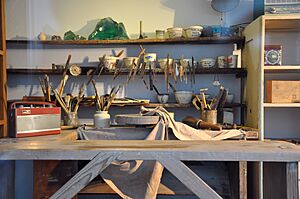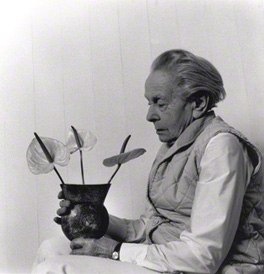Lucie Rie facts for kids
Dame Lucie Rie (born March 16, 1902 – died April 1, 1995) was a famous British studio potter. She was born in Austria but later moved to England. Lucie Rie was special because she worked as an independent potter. This was unusual at a time when most people making ceramics were men. She was known for her amazing skills and for trying out new things. She loved to experiment with glazes and firing methods. Her decorative techniques were also very unique.
Contents
About Lucie Rie
Early Life and Learning
Lucie Gomperz was born in Vienna, Austria. She was the youngest child of Gisela and Benjamin Gomperz. Her father was a doctor who even worked with Sigmund Freud. Lucie had two older brothers, Paul and Teddy. Sadly, Paul died in a war in 1917. Lucie grew up in a very open-minded family.
She decided to study pottery at a school called the Vienna Kunstgewerbeschule. This school was known for its arts and crafts. She started her studies there in 1922. Her teacher was a famous artist named Michael Powolny.
Her Work in Vienna

While living in Vienna, Lucie found inspiration from her uncle's art collection. He had many ancient Roman pots. These pots had been dug up from the ground near Vienna. This collection made her very interested in old art and buildings.
Lucie opened her first pottery studio in Vienna in 1925. She showed her work at an exhibition in Paris that same year. Her art was influenced by several styles. These included Neoclassicism, Jugendstil, modern art, and Japanese art.
In 1937, Lucie Rie won a silver medal. This was at a big international exhibition in Paris. This was the same exhibition where Pablo Picasso showed his famous painting, Guernica. Lucie had her very first solo art show in 1949.
Moving to London
In 1938, Lucie Rie had to leave Austria because of the Nazis. She moved to England and settled in London. She found a small house with a studio. She lived and worked there for the rest of her life. Around this time, she separated from her husband, Hans Rie. They had married in Vienna in 1926.
During and after World War II, Lucie needed to earn money. So, she started making ceramic buttons and jewelry. She made these for fancy fashion shops. She had to match the button colors perfectly to the clothes. This helped her become very skilled with glazes. Some of her buttons are now on display. You can see them at the Victoria and Albert Museum in London.
In 1946, Lucie hired a young man named Hans Coper. He was also from Austria and had no pottery experience. Lucie taught him how to make pots on a pottery wheel. Rie and Coper showed their art together in 1948. Coper became a partner in Lucie's studio. They remained good friends until Coper passed away in 1981.
Lucie's studio was small, located at 18 Albion Mews in London. It was a narrow street near Hyde Park. She loved having visitors and was famous for offering them tea and cake. Her studio stayed almost the same for 50 years. Today, you can see a recreation of it at the Victoria and Albert Museum.
Lucie Rie was friends with Bernard Leach, another important British potter. She admired his ideas about making a pot "complete." But her pottery was very different from his. Her work was bright, delicate, and modern. Leach's work was more traditional and rustic. Lucie also taught at Camberwell College of Arts. She taught there from 1960 until 1972.
She won many awards for her pottery. Her most famous pieces are vases, bottles, and bowls. These often had a Japanese influence. She also made other things, like her famous buttons. She gave these to her close friend, the Japanese designer Issey Miyake. She even gave her own egg cup to a publisher named Susan Shaw.
In 1982, Lucie Rie was interviewed in her studio. The famous naturalist David Attenborough interviewed her. He was a big fan of her work.
Later Years and Passing
Lucie Rie stopped making pottery in 1990. She had several strokes around that time. She passed away at her home in London on April 1, 1995. She was 93 years old.
Lucie Rie's Impact
Lucie Rie's art is known around the world. She is best remembered for her unique bowls and bottle shapes. Her pottery is displayed in many museums. These include the Museum of Modern Art in New York. You can also see her work at the York Art Gallery in the UK. The Carnegie Museum of Art in Pittsburgh also has her pieces.
Lucie Rie inspired many artists during her 60-year career. She also developed very clever ways of firing her pottery in kilns. Her studio was moved and rebuilt at the Victoria and Albert Museum. It opened in 2009 in the new ceramics gallery. She received the title of Dame Commander (DBE) for her contributions. In 2023, a big exhibition of her work was held. It was at the Holburne Museum in Bath. Over 100 of her pieces were shown. These included early works from Vienna and a raspberry-colored bowl she made when she was 88.
Awards and Special Recognition
- 1937 Silver medal at the Paris International Exhibition
- 1968 Awarded Officer of the Order of the British Empire (OBE)
- 1969 Received an honorary doctorate from the Royal College of Art
- 1981 Awarded Commander of the Order of the British Empire (CBE)
- 1991 Given the title Dame Commander of the Order of the British Empire (DBE)
- 1992 Received an honorary doctorate from Heriot-Watt University



